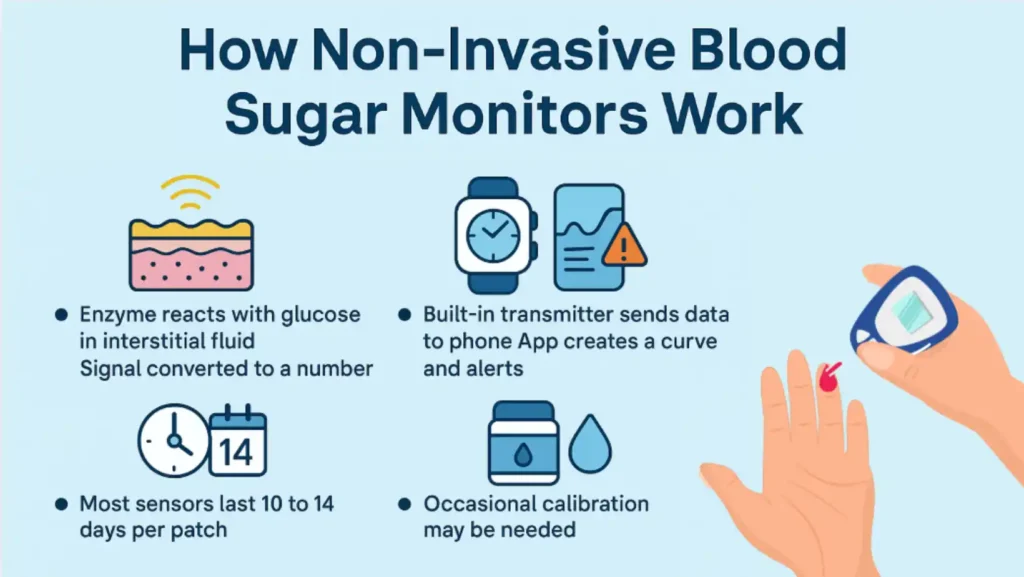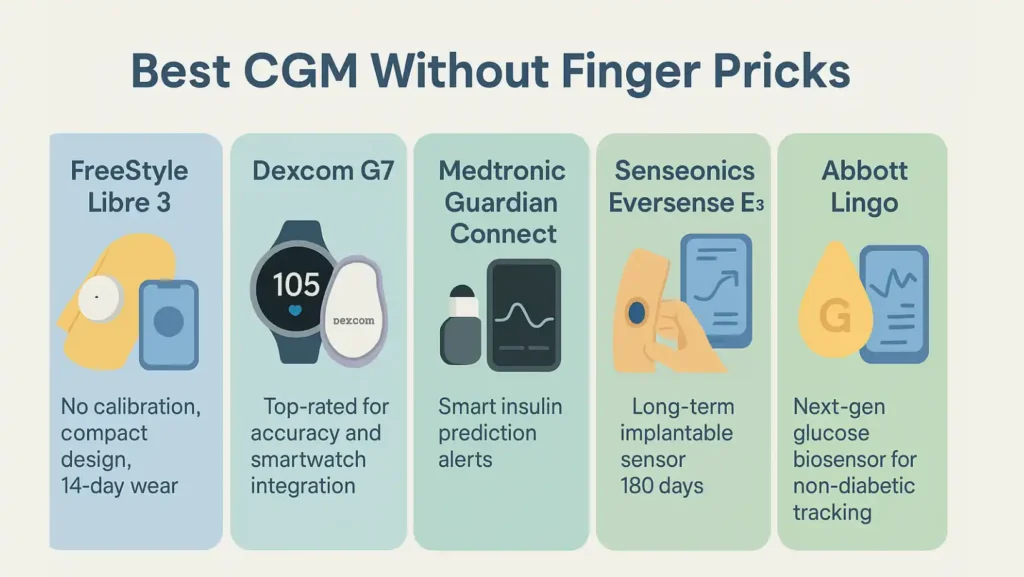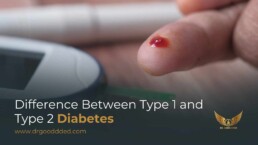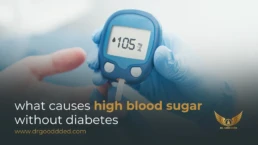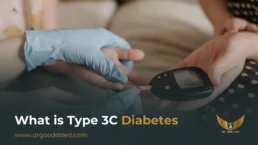A blood sugar monitor without finger pricks lets you track your glucose all day without routine finger pricks. You wear a small sensor. It reads sugar in the fluid under your skin and sends the number to your phone.
Table of Contents
ToggleYou see trends, get alerts, and share data with your doctor. You still keep a meter for rare checks when readings do not match how you feel. For most days, this tool makes glucose care simpler, faster, and less painful.
What Is A Blood Sugar Monitor Without Finger Pricks
A blood sugar monitor without finger pricks is a tiny wearable that checks glucose every few minutes. It uses a hair-thin filament under the skin. The blood sugar monitor without finger pricks talks to your phone by Bluetooth.
You see a live number and an arrow that shows if your sugar is rising, falling, or steady. You set your target range. The app warns you before lows or highs. You can share your data with a caregiver. Many systems do not need daily finger tests.
How Continuous Glucose Monitoring
Continuous glucose monitoring means you get readings many times each hour. You do not stop your tasks to test. The blood sugar monitor without finger pricks works while you work, study, or sleep. The app draws a graph. You see if a walk after dinner helps. You act early because you have trend arrows and alerts. That is the main gain of a blood sugar monitor without finger pricks.
Understanding Interstitial Fluid Tracking For Real-Time Glucose Insights
Sensors read interstitial fluid. That is the thin liquid around your cells. Glucose moves from the blood into this fluid. This move takes a few minutes. So the number can lag when sugar changes fast.
During a sprint or a quick snack spike, the gap can grow. You learn to read the arrow with the number. If the arrow points down fast, you treat a low sooner. This simple habit makes a blood sugar monitor without finger pricks very useful for daily safety.
Difference Between Traditional Glucometers And CGM Sensors
A meter gives a single point from a drop of blood. A CGM gives a live stream with arrows. A meter helps for dosing when labels ask for it, for example, with some older sensors or in special cases.
A blood sugar monitor without finger pricks helps you see the whole day. You find patterns a meter can miss, like night dips or late meal spikes. That insight supports smarter choices on food, movement, sleep, and medicine.
How Non-Invasive Blood Sugar Monitors Work
A blood sugar monitor without finger pricks uses an enzyme layer on the filament. The enzyme reacts with glucose in interstitial fluid. That reaction makes a small signal. The blood sugar monitor, without finger pricks, reads the signal and turns it into a number.
A built-in transmitter sends the number to your phone. The app plots a curve and adds alerts. You can also send data to a smartwatch. Most sensors last 10 to 14 days per patch. Some implantable options last months.
Sensors Measure Glucose Through Interstitial Fluid, Not Blood
Your blood sugar monitor without finger pricks does not sit in a vein. It sits just under the skin in the fat layer. It samples fluid in that space. That is why you may see a short lag. You plan for that by using the arrow and your symptoms.
If you feel shaky and the arrow drops, you treat the low. If you feel fine and the number is steady, you wait and recheck. Over a week, you learn your own patterns with your blood sugar monitor without finger pricks.
Role Of Transmitters And Smartphone Connectivity
Many sensors have the transmitter built in. You start a new sensor and pair it to the app. The phone stores your data. You can let a caregiver follow you. Some apps send data to a watch so you can glance at your wrist.
If your phone is not nearby, the blood sugar monitor without finger pricks keeps short-term data and uploads later. Strong Bluetooth links and simple pairing matter when you shop for the top CGM options. Your blood sugar monitor without finger pricks should fit your phone and watch.
Calibration: When And Why It’s Still Needed
Newer factory-calibrated sensors do not ask for routine finger tests. Some systems still need finger checks at set times. You calibrate when the manual says so, or when your symptoms and the number do not match. You should also check when you start a new medicine that can affect readings.
Always wash and dry your hands before a finger check. Calibrate only if the device allows it. Your sensor glucose monitor without a lancet will show a step-by-step prompt if calibration is needed.
Accuracy, Limitations, And Future Innovations
Big swings can show a larger gap between interstitial and blood values. Pressure on the patch can push readings down. Dehydration can skew numbers. Warm skin, clean placement, and firm adhesion improve results.
Future models focus on longer wear, shorter warm-up, better alerts, and easier phone links. You can expect smaller patches and more direct watch support from each non-invasive blood sugar monitor maker.
Best CGM Without Finger Pricks
Choosing the best CGM without finger pricks depends on what you value. Consider wear time, size, alerts, app design, phone and watch support, cost, and clinic help. Talk to your doctor before you switch. Here is a clear look at leading options and how they feel in daily use.
FreeStyle Libre 3 – No Calibration, Compact Design, 14-Day Wear
Libre 3 is tiny and light. You place it on the back of your upper arm. It starts after a short warm-up. It streams numbers to your phone every few minutes. You do not scan to see a number. Alerts warn you about lows and highs. The sensor lasts up to 14 days.
Most users say the patch is slim under clothes. The app gives you time in range, daily graphs, and patterns. This is a strong entry for a glucose monitor patch no finger stick.
Dexcom G7 – Top-Rated For Accuracy And Smartwatch Integration
Dexcom G7 has an all-in-one sensor and transmitter. It pairs with many phones. It also shows your number on supported watches. You can set quiet times for sleep. You can share your live data with a follower. The sensor is small and has a short warm-up.
Most people change it every 10 days. This model is a popular blood sugar monitor without finger pricks for people who want strong alerts.
Medtronic Guardian Connect – Smart Insulin Prediction Alerts
Guardian Connect focuses on predictive alerts. It warns you before a low or a high based on trend and history. The app gives guidance that helps you act sooner. Some users pair it with other Medtronic tools. Check calibration needs with your clinic. If you want early warnings, this system is worth a look.
Senseonics Eversense E3 – Long-Term Implantable Sensor 180 Days
Eversense E3 is placed by a trained provider under the skin of your upper arm. It lasts up to 180 days. You wear a small smart transmitter on top of the site. It sends data to your phone and can give on-body vibration alerts.
You follow a set calibration plan. If you want fewer insertions each year, this option can help. The blood sugar monitor without finger pricks idea here is long wear with clinic support.
Abbott Lingo – Next-Gen Glucose Biosensor For Non-Diabetic Tracking
Lingo targets adults who want to learn how food, sleep, and workouts affect glucose. The app turns swings into simple scores and tips. If you want guided habit coaching with a non-invasive blood sugar monitor, this can fit your needs. A blood sugar monitor without finger pricks for wellness can teach you fast.
Benefits Of Using A Sensor Glucose Monitor No Lancet
A blood sugar monitor without finger pricks gives you a clear view of your day. You do not guess. You see trends. You act early. Here are key gains you can expect when you switch.
Painless Monitoring – No Lancets, No Strips
You avoid routine finger sticks. You change a small patch every 10 to 14 days in most cases. Many models are factory-calibrated. You skip daily strips and reduce waste. This single change cuts stress and makes care easier with a sensor glucose monitor without a lancet. If the skin is dry, prep the site to protect comfort. The blood sugar monitor without finger pricks reduces pain and mess.
Real-Time Sugar Trend Tracking 24/7
You see your number and arrows in real time. You see a spike from a burger and fries. You watch it settle after a walk. You track sleep highs. You cut surprise lows because alerts fire early. This constant view is the top Benefits of using a Sensor Glucose Monitor for daily safety.
Predictive Alerts For Hypo Or Hyperglycemia
Smart alerts warn you when you drift out of range. Some apps predict trouble based on trends. You set ranges that match your plan. You get a calm nudge on the phone or watch. You fix a low before it gets scary. That is a clear benefit of using a glucose sensor monitor. Your blood sugar monitor without finger pricks gives you time to adjust food, movement, or insulin.
Remote Sharing With Doctors And Caregivers
You can invite a parent, partner, or nurse to follow you. They see your number and trend. This helps kids, seniors, and anyone who wants backup. Clinics can review patterns and adjust their plan faster. Sharing is helpful if you live alone or travel often. A blood sugar monitor without finger pricks that shares data builds peace of mind.
Better Lifestyle Control With Diet And Activity Correlation
You tag meals and workouts. You test small changes. Swap white rice for quinoa and see the curve. Try a 15-minute walk after dinner and watch the drop. Data turns into simple habits when you use a blood sugar monitor without finger pricks each day. Small tweaks add up over weeks.
Comparing Non-Invasive Blood Sugar Monitor Types
You will see two broad styles. Patch sensors sit on the skin and last days to weeks. Implantable sensors sit under the skin and last months. Full optical readers are still being studied. Know the trade-offs so you can choose the right non-invasive blood sugar monitor for your life.
Sensor Patches Vs Implantable Monitors
Patch sensors like Libre and Dexcom go on at home in minutes. They are simple to replace. They are good if you want no clinic visits. Implantable sensors like Eversense need a visit for insertion and removal. They last much longer. They add on body vibration alerts.
Choose patches for quick swaps. Choose implantables for fewer changes. Pick what fits your skin, schedule, and support.
Optical Glucose Monitoring – Still In Research Phase
Some groups test lasers or infrared light to read sugar through skin. Others test light passing through tiny parts of the ear or wrist. These tools aim to avoid any filament. But they must prove stable results across skin types, sweat, and motion.
For now, you should use proven devices for dosing choices. Follow trials if you care about new tech. The blood sugar monitor without finger pricks future may include optical tools after proof is strong.
Sweat, Saliva, And Skin-Based Glucose Sensors
Sweat and saliva sensors look at sugar in these fluids. The blood link is not steady yet in daily life. They may help fitness users first. Keep an eye on trials. These may feed the next generation of top CGM ideas. A blood sugar monitor without finger pricks that reads sweat must show stable links in real life before wide use.
Smartwatches And Wearables For Glucose Detection
Many CGMs already send numbers to watches. That is handy for runs, class, or meetings. Pure watch-only sensing is still being tested. When that arrives, you may get a true blood sugar monitor without finger pricks that feels like a simple watch. Until then, pair your patch to a watch for quick checks. Check adhesives weekly.
How To Use A Blood Sugar Monitor Without Finger Pricks
You set yourself up in a few clear steps. Wash the site and dry it well. Do not use thick lotion. Choose the back of the upper arm or abdomen as your label allows. Avoid spots that rub on belts or straps. Open the applicator. Press it flat on the skin. Hold for a slow count of ten. Start the sensor in the app and keep the phone close until pairing completes.
When the graph appears, check the number and the arrow. A flat arrow means steady. A single up arrow means rising. A single down arrow means falling. Two arrows show a faster change. Use trends when you plan meals, workouts, and sleep. Review your time in range each week.
If the patch starts to peel, add an overpatch from your brand. If the reading and your symptoms do not match, do a clean finger test and follow your care plan. Check adhesives weekly.
Accuracy And Limitations Of Non-Invasive Glucose Monitoring
A blood sugar monitor without finger pricks checks glucose in interstitial fluid. This fluid changes a little slower than blood. So, when sugar changes fast, like after a heavy meal or a sprint, the reading may trail slightly. You rely on trend arrows to understand the speed of change.
When you see downward arrows, treat lows early. When you see upward arrows, adjust food or movement. With use, you learn how your body reacts. Your habits improve because you get clear feedback. This is another clear benefit of using a glucose sensor monitor for learning patterns that last.
CGM Readings vs Traditional Glucometer Readings
A meter checks a drop of blood, so it shows a moment. A CGM checks fluid under the skin often, so it shows a pattern. For insulin dosing, some doctors ask you to check with a meter when your symptoms disagree with your reading. If you feel low, treat it, even if the screen shows normal. Safety comes first.
Why Interstitial Glucose May Differ Slightly From Blood Glucose
Glucose first rises in the blood, then moves into the interstitial fluid. This step takes a few minutes. So, during fast shifts, a CGM may show a lag. You learn to watch the arrow more than the number alone. A slow, steady climb lets you adjust food calmly. A sharp fall means you fix a low right away. Your sensor glucose monitor without a lancet helps you stay ahead of changes.
Conditions Affecting Accuracy
You may see temporary errors if:
- The patch is loose
- Your skin is very sweaty
- You sleep with pressure on the sensor
- You are dehydrated
Fix the cause, and the reading returns to normal. Stay hydrated and avoid pressing on the sensor while sleeping. A non-invasive blood sugar monitor works best when your skin is clean and dry at placement.
How To Ensure Reliable Readings
- Always wash and dry skin before placing a sensor
- Let the skin dry fully after cleaning
- Avoid placing over scars or damaged skin
- Use over-patches if the patch begins peeling
- Check finger blood only when symptoms and reading do not match
Cost And Availability Of Finger-Stick Free Glucose Monitors
Costs vary by country, brand, insurance, and sensor cycle. Most sensors come in packs and need replacement every 10 to 14 days. Implantable sensors last months but require clinician’s placement.
Average Price Range
Wearable patches, like Libre and Dexcom, tend to cost less in some regions and more in others. If insurance covers diabetes tools, your cost may be lower. If you pay out of pocket, compare pharmacy prices and official distributor shops.
Subscription vs One-Time Purchases
Some brands offer monthly plans where you receive sensors by mail. Others require picking up replacements at the pharmacy. Subscription options may reduce price swings and save time.
Cost Comparison: CGM vs Test Strips
Strips seem cheaper at first. But if you check often, strips add up fast. A CGM gives thousands of readings each month. It also gives alerts and trends that strips cannot offer. Many users find that long term, a glucose monitor patch no finger stick provides more value per month.
Coverage In Different Countries
Some health plans in India, the US, and Europe cover CGM for insulin users. Wellness-focused devices may not be covered and are usually paid by the user. Ask your doctor for medical documentation if your insurance requires approval.
Emerging Lower-Cost Options
New companies are entering the market. As more brands appear, prices may drop. Clinics and digital health programs are also testing loan or rental models for trial periods. If cost is a barrier, ask your doctor about assistance programs.
Who Should Use A Non-Invasive Glucose Monitor Patch No Finger Stick
A blood sugar monitor without finger pricks can support many people, not just those using insulin.
Type 1 And Type 2 Diabetes
If you check often or use insulin, CGM can help you stay safe. You see lows sooner. You understand meal effects. You reduce stress at night.
Prediabetes And Insulin Resistance
Some doctors recommend short-term CGM to learn which meals trigger spikes. A few days of data can change how you plan breakfast, lunch, and snacks. A blood sugar monitor without finger pricks teaches you through direct feedback.
Fitness And Nutrition Users
Some people want to track how exercise changes sugar. Wellness-focused tools help them learn patterns without medical dosing decisions. This can help shape smart eating plans.
Children, Teens, And Seniors
Sharing and alerts support safety. Parents or caregivers can see numbers live. This reduces fear and helps during school, sleep, or travel.
Maintenance And Sensor Care For CGM Users
A blood sugar monitor without finger pricks needs simple care.
Skin Care And Cleaning Before Sensor Application
Wash with mild soap. Dry fully. Avoid oils and lotion. If your skin is sensitive, use sensor-safe barrier wipes.
Avoiding Irritation And Patch Peeling
Do not place on areas that bend or rub. If you sweat a lot, use an over-patch. Let the skin rest between placements.
Replacing Sensors Safely
Remove the old sensor slowly. Apply a new one on a fresh spot. Rotate sides each time to keep the skin healthy.
When To Contact Support Or Your Doctor
Call support if:
- The sensor will not pair
- The patch falls off early
- The reading jumps wildly with no reason
Call your doctor if:
- You see persistent redness or pain
- Your numbers stay out of range despite adjustments
FAQs
Are CGMs accurate without finger pricks?
Most modern CGMs are accurate for daily use. Your blood sugar monitor without finger pricks may still need a finger test if symptoms and readings differ or during rapid glucose changes.
How does a non-invasive glucose monitor measure sugar?
A non-invasive blood sugar monitor reads glucose in the fluid under your skin. It then sends the signal to your phone, where you see the number and trend arrows.
Can I use a CGM if I am not diabetic?
Yes, some people use it to track food and workout responses. If you use a sensor glucose monitor with no lancet for wellness, remember it is not for insulin dosing unless your doctor says so.
How often should I check my CGM data?
Most users glance at trends before meals, exercise, and bedtime. Your blood sugar monitor without finger pricks gives constant data, so you decide when to act.
Are there glucose monitor patches that need no calibration?
Yes, some models are factory calibrated. Others may require finger checks during setup. Always follow instructions for your glucose monitor patch without finger stick device.
Can dehydration or exercise affect CGM accuracy?
Yes, low hydration or heavy pressure on the patch can change readings. Always hydrate and keep the sensor secure to help your best CGM without finger pricks stay accurate.

This article is medically reviewed by Dr. Nivedita Pandey, Senior Gastroenterologist and Hepatologist, ensuring accurate and reliable health information.
Dr. Nivedita Pandey is a U.S.-trained gastroenterologist specializing in pre and post-liver transplant care, as well as managing chronic gastrointestinal disorders. Known for her compassionate and patient-centered approach, Dr. Pandey is dedicated to delivering the highest quality of care to each patient.

